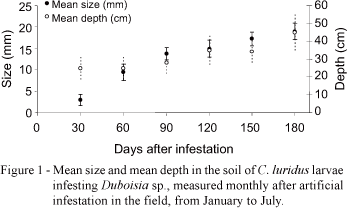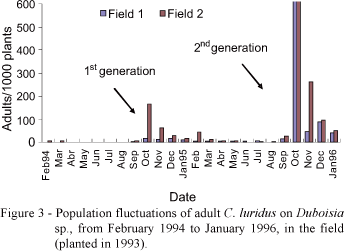Cyrtomon luridus (Boheman) has adapted to the medicinal plant Duboisia sp., introduced from Australia. Its larvae feed on roots, causing up to 100% mortality damages. The population dynamics and biological cycle were studied to determine future control methods in Duboisia sp., in Arapongas, Paraná State, Brazil, from 1993 to 1996. C. luridus presented annual life cycle in Duboisia sp. under natural conditions. The larval development period was 120 to 150 days, from January to May, reaching an average size of 19.0 ± 2.0 mm in soil depth ranging on 24.9 ± 8.6 cm to 45.0 ± 10.0 cm. The beginning of the pupal phase happened in April. The larval-adult viability ranged on 7.5% to 19.6%. The typical symptoms of attack appeared in an infestation level of 60 larvae per plant. The first adults came out in July, six months after larvae hatching. However, adults came out from soil only in September, at the beginning of the rainy season, reaching the peak of emergency in October, outspreading until January. In laboratory (25ºC, 70% R.H.), females longevity averaged 113.7 ± 15.2 days. In this period, laying capacity was 42.7 ± 7.9 egg masses, with 9.4 ± 0.61 eggs each, totaling 402 ± 72.9 eggs per female. Adults C. luridus were found parasitized by Microctonus sp. (Loan) (Hymenoptera: Braconidae). Solanaceae species Solanum mauritianum Scopoli and Cestrum intermedium Sendt. were identified as host plants of C. luridus.
Microctonus; biological cycle; medicinal plant; control; longevity





